
Pteris (brake) is a genus of about 300 species of ferns in the subfamily Pteridoideae of the family Pteridaceae. They are native to tropical and subtropical regions, southward to New Zealand, Australia, and South Africa, north to Japan and North America. 78 species are found in China. Some species of Pteris have considerable economic and ecological value, such as Pteris multifida, Pteris ensiformis, Pteris vittata can be used for ornamental purposes; as a hyperaccumulator, Pteris multifida and Pteris vittata can be used to control soil pollution.
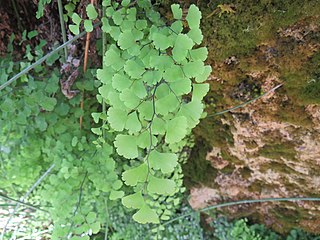
Adiantum capillus-veneris, the Southern maidenhair fern, black maidenhair fern, maidenhair fern, and venus hair fern, is a species of ferns in the genus Adiantum and the family Pteridaceae with a subcosmopolitan worldwide distribution. It is cultivated as a popular garden fern and houseplant.

Sphaeropteris cooperi, synonym Cyathea cooperi, also known as lacy tree fern, scaly tree fern, or Cooper's tree fern, is a tree fern native to Australia, in New South Wales and Queensland.
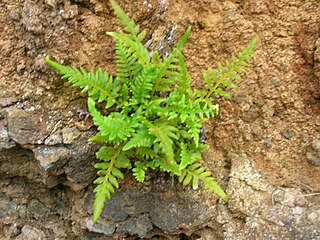
Pteridaceae is a family of ferns in the order Polypodiales, including some 1150 known species in ca 45 genera, divided over five subfamilies. The family includes four groups of genera that are sometimes recognized as separate families: the adiantoid, cheilanthoid, pteridoid, and hemionitidoid ferns. Relationships among these groups remain unclear, and although some recent genetic analyses of the Pteridales suggest that neither the family Pteridaceae nor the major groups within it are all monophyletic, as yet these analyses are insufficiently comprehensive and robust to provide good support for a revision of the order at the family level.

Pellaea andromedifolia, with the common names coffee cliffbrake and coffee fern, is a species of cliff brake fern in the Cheilanthoideae subfamily of the Pteridaceae. It is native to California in the United States and Baja California in Mexico.

Pteris vittata, commonly known variously as the Chinese brake, Chinese ladder brake, or simply ladder brake, is a fern species in the Pteridoideae subfamily of the Pteridaceae. It is indigenous to Asia, southern Europe, tropical Africa and Australia. The type specimen was collected in China by Pehr Osbeck.

Adiantum pedatum, the northern maidenhair fern or five-fingered fern, is a species of fern in the family Pteridaceae, native to moist forests in eastern North America. Like other ferns in the genus, the name maidenhair refers to the slender, shining black stipes.
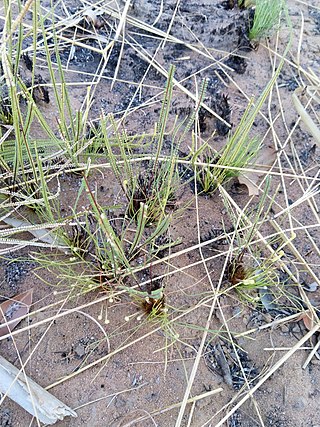
Pteris platyzomopsis, synonym Platyzoma microphyllum, is a fern in the family Pteridaceae. When placed in the genus Platyzoma, it was the only species; the genus was sometimes placed in its own family, Platyzomaceae. The species is native to northern Australia, occurring in the Kimberley region of Western Australia, in the Northern Territory and Queensland, and in northern New South Wales, where it is considered endangered. Vernacular names include braid fern.

Pellaea atropurpurea, commonly known as purple-stem cliffbrake or just purple cliffbrake, is a fern native to North and Central America. Brake is an old word for fern, related to the word bracken. Like many other members of the Pteridaceae, it is a rock plant, needing a calcareous substrate.

Jamesonia is a genus of ferns in the subfamily Pteridoideae of the family Pteridaceae. It now includes the formerly separate genus Eriosorus.
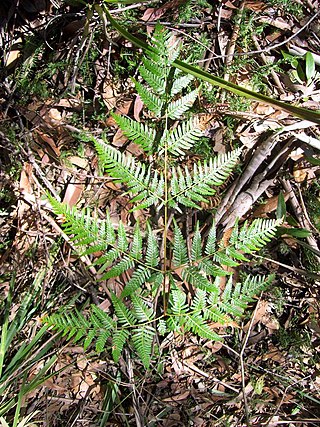
Pteridium esculentum, commonly known as bracken fern, Austral bracken or simply bracken, is a species of the bracken genus native to a number of countries in the Southern Hemisphere. Esculentum means edible. First described as Pteris esculenta by German botanist Georg Forster in 1786, it gained its current binomial name in 1908. The Eora people of the Sydney region knew it as gurgi.

Angiopteris evecta, commonly known as the king fern, giant fern, elephant fern, oriental vessel fern, Madagascar tree fern, or mule's Foot fern, is a very large rainforest fern in the family Marattiaceae native to most parts of Southeast Asia and Oceania. It has a history dating back about 300 million years, and is believed to have the longest fronds of any fern in the world.
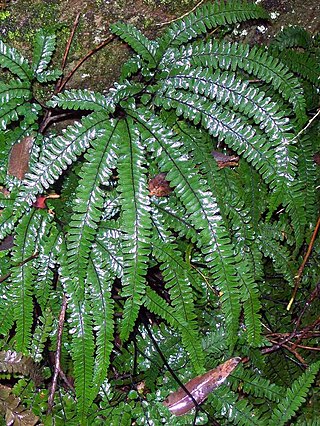
Adiantum hispidulum, commonly known as rough maidenhair fern or five-fingered jack, is a small fern in the family Pteridaceae of widespread distribution. It is found in Africa, Australia, Polynesia, Malesia, New Zealand and other Pacific Islands. Its fronds rise in clumps from rhizomes among rocks or in the soil in sheltered areas.

Pteris ensiformis, the slender brake, silver lace fern, sword brake fern, or slender brake fern, is a plant species of the genus Pteris in the family Pteridaceae. It is found in Asia and the Pacific.
Pteris lydgatei is a rare fern species in the Pteridoideae subfamily of the Pteridaceae. It is known by the common name Lydgate's brake and is endemic to Hawaii, where it is known from the islands of Oʻahu, Molokaʻi, and Maui. It was once thought to be extinct until it was rediscovered in the 1990s. There are fewer than 40 individuals in the wild. This is a federally listed endangered species of the United States.
Calciphilopteris is a genus of ferns in the family Pteridaceae. It is native to India and China, southward to Australia. Its four species grow in crevices in limestone or they cling to the rock itself.
Pteris longifolia, the longleaf brake is a species of fern in the Pteridoideae subfamily of the Pteridaceae.

Pteris cretica, the Cretan brake, ribbon fern, or Cretan brake fern, is a species of evergreen fern in the family Pteridaceae, native to Europe, Asia and Africa.
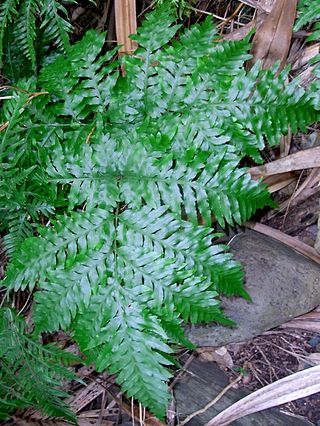
Pteris microptera is a fern in the family Pteridaceae.















